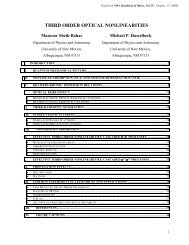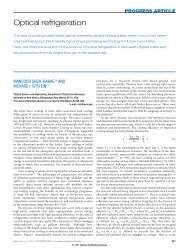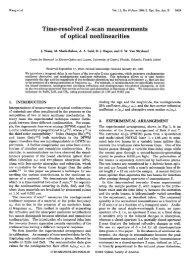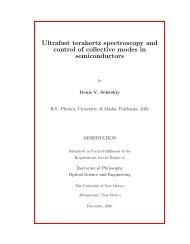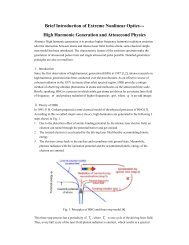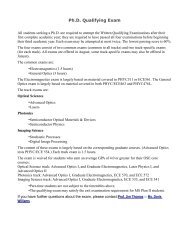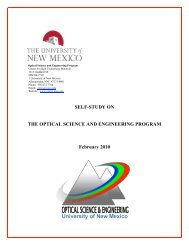Absorption spectra of wide-gap semiconductors in their ...
Absorption spectra of wide-gap semiconductors in their ...
Absorption spectra of wide-gap semiconductors in their ...
You also want an ePaper? Increase the reach of your titles
YUMPU automatically turns print PDFs into web optimized ePapers that Google loves.
B. Imangholi et al. / Optics Communications 227 (2003) 337–341 341<br />
Probe Transmittance at Peak (AU)<br />
3.5<br />
3.0<br />
2.5<br />
2.0<br />
1.5<br />
1.0<br />
0.5<br />
0.2 0.4 0.6 0.8 1.0 1.2<br />
Fig. 5. Nonl<strong>in</strong>ear thermal refraction obta<strong>in</strong>ed with ZnSe.<br />
Dotted l<strong>in</strong>e represents model fitt<strong>in</strong>g <strong>in</strong>clud<strong>in</strong>g degenerate twophoton<br />
absorption <strong>of</strong> pump photons. Solid l<strong>in</strong>e is a l<strong>in</strong>ear<br />
extrapolation <strong>of</strong> the low irradiance data.<br />
TPA. When the far-field aperture is removed, the<br />
Z-scan signal will reveal only nonl<strong>in</strong>ear absorption.<br />
This so-called open aperture data are then<br />
subtracted from data taken with a partially<br />
transmitt<strong>in</strong>g aperture to extract the thermal-refraction<br />
signal. The Z-scan data shown <strong>in</strong> Fig. 3<br />
are corrected for nonl<strong>in</strong>ear absorption <strong>in</strong> this way.<br />
Two-photon absorption is a third-order nonl<strong>in</strong>ear<br />
optical process; observation <strong>of</strong> this effect<br />
normally requires large optical electric fields associated<br />
with pulsed, high irradiance laser beams.<br />
Detection <strong>of</strong> TPA with only cw beams is an <strong>in</strong>dication<br />
<strong>of</strong> the high sensitivity <strong>of</strong> our excite-probe<br />
technique. The dotted l<strong>in</strong>e <strong>in</strong> Fig. 5 represents a<br />
calculation that <strong>in</strong>cludes both l<strong>in</strong>ear absorption<br />
and degenerate TPA. We fit the data us<strong>in</strong>g a TPA<br />
coefficient <strong>of</strong> b ¼ 3:2 cm/GW. A value <strong>of</strong> 3.5 cm/<br />
GW was obta<strong>in</strong>ed previously at k ¼ 780 nm by<br />
us<strong>in</strong>g high power, ultrashort laser pulses [8]. A<br />
calculation based on a 3-band model <strong>of</strong> a semiconductor<br />
(light- and heavy-hole valence bands<br />
and a conduction band) yields 2.1 and 3.95 cm/GW<br />
at wavelengths <strong>of</strong> 850 and 780 nm, respectively [9].<br />
No evidence <strong>of</strong> TPA is seen <strong>in</strong> the other materials.<br />
TiO 2 and ZnS are not two-photon resonant<br />
at Ti:sapphire laser wavelengths. The large background<br />
absorption prevents observation <strong>of</strong> TPA <strong>in</strong><br />
GaP. The first report <strong>of</strong> TPA us<strong>in</strong>g cw lasers was<br />
an <strong>in</strong>direct measurement <strong>in</strong>volv<strong>in</strong>g the magnetophotoconductivity<br />
<strong>of</strong> InSb [10]. Here, we make<br />
what we believe is the first direct observation <strong>of</strong><br />
nonl<strong>in</strong>ear transmission <strong>of</strong> a cw laser beam <strong>in</strong>duced<br />
by TPA.<br />
In summary, we have used a sensitive, two-color<br />
Z-scan technique to measure the absorption coefficients<br />
<strong>of</strong> ZnS, ZnSe, TiO 2 , and GaP <strong>in</strong> <strong>their</strong><br />
transparency wavelength range between 840 and<br />
900 nm. We attribute this background l<strong>in</strong>ear absorption<br />
to transitions <strong>in</strong>volv<strong>in</strong>g the Urbach tail<br />
and the presence <strong>of</strong> uncontrolled impurities. It is<br />
found that ZnS has the lowest absorption coefficient,<br />
which makes it suitable for use as a dome<br />
lens to remove lum<strong>in</strong>escence <strong>in</strong> laser cool<strong>in</strong>g experiments<br />
with GaAs. We also observe two-photon<br />
absorption with ZnSe us<strong>in</strong>g only cw laser<br />
beams. In this case, the nonl<strong>in</strong>ear absorption can<br />
be comparable to the background l<strong>in</strong>ear absorption<br />
at sufficiently high irradiance.<br />
Acknowledgements<br />
We acknowledge fund<strong>in</strong>g by NASA Grant<br />
NAG5-10373 and the Air Force Office <strong>of</strong> Scientific<br />
Research.<br />
References<br />
[1] C.W. Hoyt, M.P. Hasselbeck, M. Sheik-Bahae, R. Epste<strong>in</strong>,<br />
S. Greenfield, J. Thiede, J. Distel, J. Valencia, J. Opt. Soc.<br />
Am. B 20 (2003) 1066.<br />
[2] H. Gauck, T.H. Gfroerer, M.J. Renn, E.A. Cornell, K.A.<br />
Bertness, Appl. Phys. A 64 (1997) 143.<br />
[3] M. Sheik-Bahae, R. Epste<strong>in</strong>, Phys. Rev. Lett. (submitted).<br />
[4] A. OÕKeefe, D.A.G. Deacon, Rev. Sci. Instrum. 59 (1988)<br />
2544.<br />
[5] A. Marcano, C. Loper, N. Melekechi, Appl. Phys. Lett. 78<br />
(2001) 3415.<br />
[6] A. Marcano, C. Loper, N. Melekechi, J. Opt. Soc. Am. B<br />
19 (2002) 119.<br />
[7] N.S. Gluck, H. Sankur, J. Heuer, J. Denatale, W.J.<br />
Gunn<strong>in</strong>g, J. Appl. Phys. 69 (1991) 3037.<br />
[8] T.D. Krauss, F.W. Wise, Appl. Phys. Lett. 65 (1994) 1739.<br />
[9] M. Sheik-Bahae, Phys. Rev. B 60 (1999) R11257.<br />
[10] D.G. Seiler, M.W. Goodw<strong>in</strong>, M.H. Weiler, Phys. Rev. B 23<br />
(1981) 6806.


